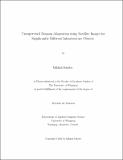| dc.contributor.author | Sokolov, Mikhail | |
| dc.date.accessioned | 2022-03-29T19:11:12Z | |
| dc.date.available | 2022-03-29T19:11:12Z | |
| dc.date.issued | 2022-03-28 | |
| dc.identifier.citation | Sokolov, Mikhail. Unsupervised Domain Adaptation using Satellite Images for Significantly Different Infrastructure Objects; A Thesis submitted to the Faculty of Graduate Studies of The University of Winnipeg in partial fulfillment of the requirements of the degree of Master of Science, Department of Applied Computer Science, University of Winnipeg, Winnipeg, Manitoba, Canada. Winnipeg: University of Winnipeg, 2002. DOI: 10.36939/ir.202203291405. | en_US |
| dc.identifier.uri | https://hdl.handle.net/10680/1989 | |
| dc.description.abstract | Deep learning has become one of the most efficient computer vision tools in recent years. The success and variety of deep learning semantic segmentation models inspired scientists in the remote sensing domain to apply them to satellite imagery. Here, these models can produce reliable land use land cover maps in a short amount of time. However, porting these models to new sensors or domains is still limited by the amount of labelled data for training the network. The image labelling process is time-consuming and expensive because it is often manual (or semi-automated) work and requires assigning a label to each pixel in a satellite image. One solution is to apply the semantic segmentation model trained on a domain with known labels to a domain where labels are missing. For this to work, the discrepancy between domains must be narrowed to produce acceptable results. However, in practice, domain discrepancy can be significant. Developing domain adaptation models to bridge this discrepancy is the problem considered in this thesis, and it is important because semantically similar objects can look different from one geographical area to another. Therefore, several state-of-the-art domain adaptations were considered and validated using GeoEye-1 and WorldView-2 satellite imagery. The GeoEye-1 images represented a Canadian land cover, and WorldView-2 represented the African continent; thus, the domain discrepancy was significant. The CyCADA model with adapted noisy labeller showed the highest performance among all the considered models and achieved 32.6% of mean intersection over union, which is 7.5% higher compared to the model without adaptation. The contributions of this thesis are an attempt at domain adaptation across domains with the significant structural discrepancy, structural improvements to the CyCADA and DAugNet models, and quantitative and qualitative analysis of model performance on domain adaptation with significant structural discrepancy. | en_US |
| dc.description.sponsorship | Manitoba Hydro, Arctic Gateway Group, Mitacs, NSERC, the Faculty of Graduate Studies | en_US |
| dc.language.iso | en | en_US |
| dc.publisher | University of Winnipeg | en_US |
| dc.rights | info:eu-repo/semantics/openAccess | en_US |
| dc.subject | Deep learning (DL) | en_US |
| dc.subject | Land use and land cover (LULC) | en_US |
| dc.subject | Domain adaptation | en_US |
| dc.subject | Semantic segmentation | en_US |
| dc.subject | Convolutional neural network (CNN) | en_US |
| dc.subject | Remote sensing | en_US |
| dc.subject | Satellite images | en_US |
| dc.title | Unsupervised Domain Adaptation using Satellite Images for Significantly Different Infrastructure Objects | en_US |
| dc.type | Thesis | en_US |
| dc.description.degree | Master of Science in Applied Computer Science | en_US |
| dc.publisher.grantor | University of Winnipeg | en_US |
| dc.identifier.doi | 10.36939/ir.202203291405 | en_US |
| thesis.degree.discipline | Applied Computer Science | |
| thesis.degree.level | masters | |
| thesis.degree.name | Master of Science in Applied Computer Science | |
| thesis.degree.grantor | University of Winnipeg | |

